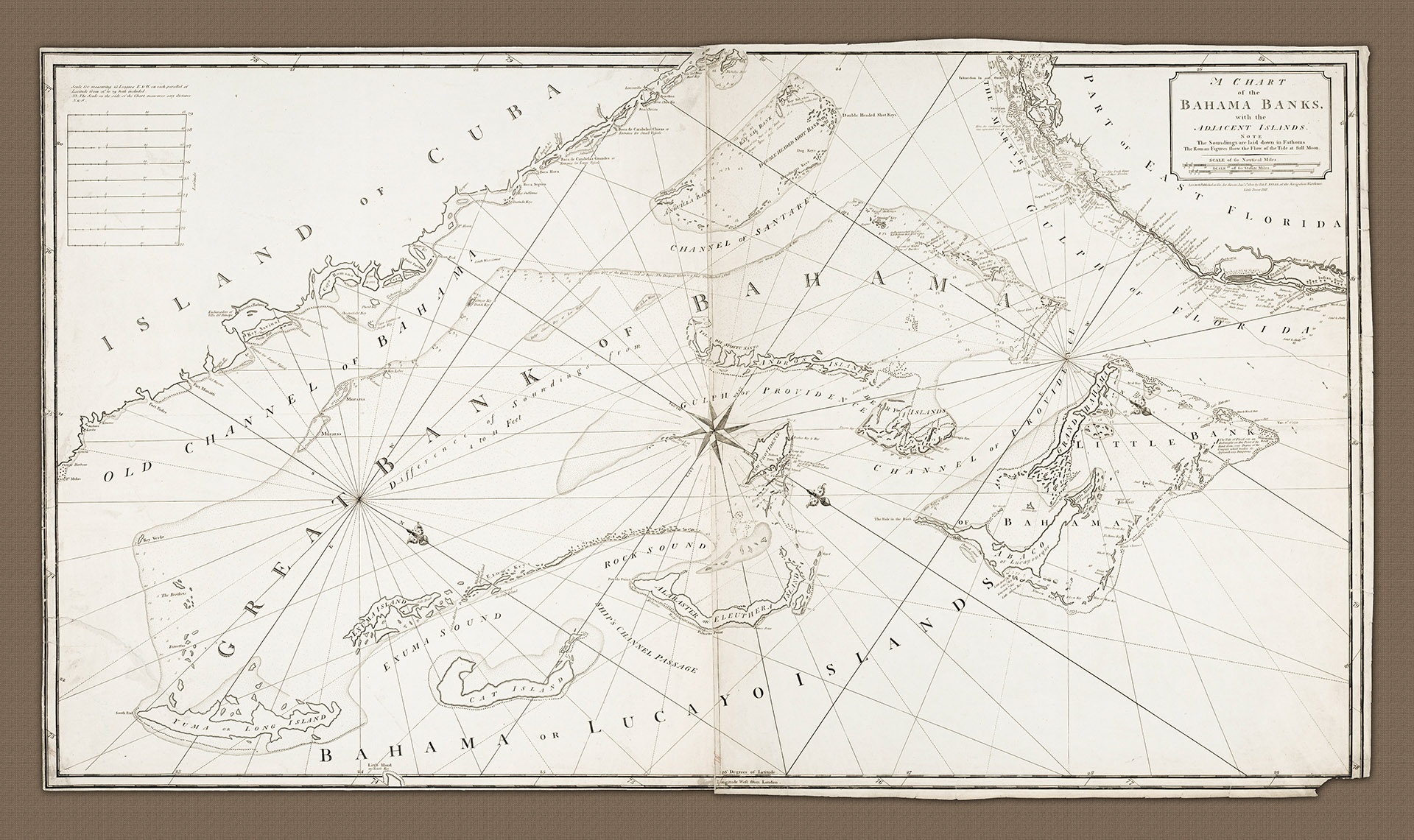A721 - A Chart of the Bahama banks, with the Adjacent Islands
This rare, and unusual chart was published in London by David Steel at his Navigation Warehouse in London. It is especially unusual for its orientation which depicts North to the East-Southeast as itis presented. It is likely laid out in this orientation as much for artistic reasons as any.
- 1800
- Unknown
- h33" x w55.5"
- L
By 1800 British map and Chart making was at its peak with publishing houses in London especially, all vying to produce the most attractive and informative material for consumption by the armchair strategist, politician and investor in the leading commercial city of the world.
The orientation is reminiscent of early Spanish and Dutch charts which would not just take latitude from their home ports but also orientate to show the direction from their ships would approach the American continent. In many respects this makes complete sense as the reader is given a view of approach. Thereafter, it is senseless as a tool for navigation through the Bahama channels going north or south, to or from the Cuba, or other destinations.
Steel makes full use of 'rhumb' or 'loxodromic' lines [1], along with 3 compass roses, to give the chart a nautical feel. The use of such embellishment was typical also of the charts produced by other publishers such as Thomas Jeffreys and Sayer & Bennett, around this time. Just to add credibility Steel includes a scale with which to measure distance (leagues) along each parallel of Latitude.
Cartographic detail on both the island of Cuba and mainland Florida is not surprisingly kept to coastal features including harbors, anchorages, sandbanks, rocks, off-shore Keys and specific land relief features such as Turtle Mounds [2]. The chart clearly shows their presence on the Island of Cuba as well on Key Savinal.
The style of engraving, as well as the information provided is extremely similar to Thomas Jeffreys chart The Peninsula and Gulf of Florida or New Bahama Channel with the Bahama Islands (see Heritage Charts A412). Both charts for instance note the Frigate Carisfort ran aground oct. 23 1770 on the mainland of Florida. This is perhaps less of a co-incidence than may at first appear as publishers at the time were well known for sharing information and may well have worked off the same manuscript surveys or old editions of a chart in order to produce their latest charts.
Much of the information provided by Steel on the Bahama Islands is once again of a fairly general nature with references to such things as 'White Water & Plenty of Fish' and 'Galleon wrecked in 1765 her bottom in 17 Feet water'. Soundings (in fathoms) are included on the chart, in a limited and almost stylish manner, mainly amongst the Bahama Keys whilst flood or tide arrows are reserved for the main Bahama Channel.
[1] Taken from an initial bearing it is a line on a sphere that cuts all meridians at the same angle. It is the path taken by a ship that maintains a constant compass direction). Such lines were only really useful in waters that were bounded by not too distant landfall as they did not take account of the curvature of the earth.
[2]. Turtle mounds were in fact mainly made up of oyster shells, vegetation and general (historic) refuse. The mounds were built by the native Indians and in some cases such as at New Smyrna Beach Florida, they are still there today. In his General Descriptions which accompanied his work around West Florida, George Gauld noted 'large hillocks of Oyster Shells' being found on raised ground where native Indians had encampments. He further commented that he had discovered 'many such vestiges of the ancient inhabitants in several bays and other places on the coast'.
- A Chart of the Bahama banks, with the Adjacent Islands


